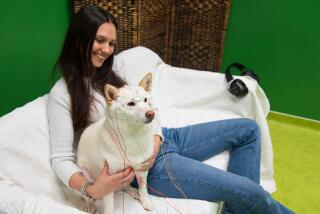Brain implant improves decision-making in monkey
- Share via
A group of scientists created a novel brain implant that improves cognitive performance and decision-making in a monkey. The device, developed in part by researchers at USC, manipulates ongoing brain activity to guide the animal away from mistakes and toward a correct decision.
The study, published this week in the Journal of Neural Engineering, marks an important step toward implantable devices that could one day help people with brain injuries better perform basic tasks.
The field of “brain prosthetics” has been dominated by efforts to restore physical abilities, like devices that use brain activity to move a robotic arm or a cursor across a screen. But the new study records an attempt to actually improve the thinking ability of a monkey, a tall task given that even the most simple cognitive tasks requires the coordination of millions of brain cells.
But scientists now have unprecedented capabilities to record and analyze ongoing brain activity on an extremely small spatial scale and with previously unattainable accuracy, allowing researchers to capture, in a small region of the brain, the pattern of brain activity that marks a correct decision.
Here’s how they did it. First, the researchers trained a monkey to perform a relatively simple task: to look at an image, and then pick that image out of a group of several images. When the monkey did this right, it got a reward.
After two long years of training, the monkeys got quite good at the task. At that point, the researchers turned on their recording device, which was placed in a part of the brain called the pre-frontal cortex, an area believed to be essential to decision-making and thought.
Every time the monkey guessed correctly, the device stored the sequence of neural activity that occurred during the decision-making process, making a record of a correct decision. Once the team had a good handle on what the pattern of brain activity looked like when the monkey made a correct decision, they began feeding that pattern into the monkey’s pre-frontal cortex while the animal was about to make a decision-like installing a temporary software program. The monkey’s performance immediately jumped about 10%.
But seeing an increase in performance in healthy monkeys was not enough for the researchers, because they wanted to be sure the device would help those with cognitive deficits -- the likely beneficiaries of any such device in humans. So they gave their monkeys cocaine, which is well known to impair their decision-making ability. They they repeated the experiment, again feeding in the “correct answer” software at just the right moment during decision-making. Even though the monkeys had been performing more poorly after cocaine usage, their performance suddenly jumped back above normal when the stimulator was turned on.
The research team believes the device could represent the prototype for an assistive device for those who have had brain injuries, strokes, or suffer from neurodegenerative diseases, and may help such people complete basic tasks. But much more work needs to be done before it is clear exactly how useful such a device would be. It is unknown, for example, whether the device would need to record a separate template for every possible type of decision, a number that would soon become impossibly large.
Still, the study is enough to allow one to imagine a future in which people with cognitive disabilities can more easily re-enter the workforce and care for their families.
You can read a summary of the study here.
Return to the Science Now blog.






